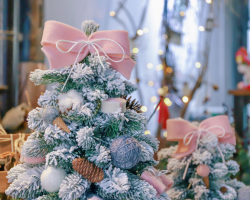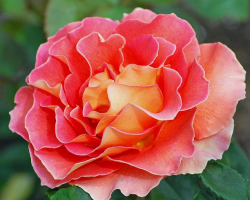Every adult and a child should know the signs of poisonous plants. This will help to protect yourself from poisoning.
Content
- Safety rules with vegetable poisons
- The world around the world, grade 4 - “Signs of toxic plants”: Memo
- Signs of poisoning with poisonous plants: what to do in case of poisoning?
- Yellow grass in the fields - Ambrosia: why is it so called, what does it look and what is dangerous?
- Black berry on the bushes: what is it called, what is dangerous?
- Herba Borshshik: what does it look like, what is dangerous?
- Video: 10 plants from which it is better to stay away
- Video: Poisonous plants
During travels, going to nature and just rest in the fresh air, people have to, one way or another, interact with many plants. Some of them are absolutely safe and cannot harm a person. Others are so poisonous that even touching them can lead to health problems.
Read on our website another article on the topic: "The most interesting plants in the world are strange, poisonous, beautiful, rare, dangerous.". You will find a description, photo.
It is important to focus on which representatives of the flora are dangerous, and also what to do if the plant has already harmed a person. We will consecrate this topic in the article below. Read further.
Safety rules with vegetable poisons

In order to avoid poisoning with plant poisons, you should adhere to a number of safety rules. First of all, the danger of poisoning occurs when using toxic plants as medical means in traditional medicine. It should be remembered that from herbs, berries and flowers you can create a medicine in laboratory conditions, but when using the house, hazardous substances can form in them.
General safety rules are as follows:
- Do not use unfamiliar plants and their parts.
- Do not consume agricultural crops that were incorrectly stored or grown.
- Do not use folk medical remedies without coordination with your doctor.
- Do not change the dosage of drugs prescribed by a health worker.
- Do not let children collect berries on their own without adult supervision.
- Do not use unverified plant remedies as drugs recommended not by specialists, but by folk healers, healers, etc.
One of the preventive measures against vegetable poisoning is also knowledge of the exact description of the appearance of dangerous representatives of the flora.
The world around the world, grade 4 - “Signs of toxic plants”: Memo
The main signs of toxic plants are studied in grade 4 during the course of the subject "The World". Most dangerous representatives of the flora have a number of signs by which they can be qualified as poisonous. Each house should have a memo with these signs, so that the child knows what inedible berries, herbs and other plants look like.
Among the main features of poisonous plants, they distinguish:
- The juice of leaves and stems has a milky white color.
- Berries are most often yellow or white.
- Plant leaves have an unnatural glossy brilliance. In some poisonous representatives of the flora, they have a dim green color.
- Inflorescences are most often umbrella shape.
- The leaves and stems of plants are covered with hard villi.
- Poisonous plants can distinguish an unpleasant odor.
It is worth noting that not all representatives of the flora with one or more similar signs are dangerous.
Signs of poisoning with poisonous plants: what to do in case of poisoning?
Signs of poisoning with poisonous plants: what to do?
Poisoning poisoning with poisonous plants have different signs that depend on the type of poison and what organs of the body it affects.
In modern medicine, the following symptoms of poisoning with dangerous plants are known:
- With poisoning with neurotoxic species of floraFirst of all, the central nervous system is affected. This is manifested in the appearance of headaches, hallucinations, a sharp change in human behavior and the image of his thoughts. In the absence of treatment, conditions occur stupor, inhibition of consciousness, coma. In parallel, there may be a symptom of the digestive tract - nausea, vomiting, the hoarseness of the voice, dry mucous membranes, tachycardia appear. Such symptoms are inherent in poisoning bleached, dope, horsetail, handsome.
- Cardiotropic plants affect the work of the cardiovascular system. The victim is observed arrhythmia, tachycardia, patients complain of pain in the heart and a feeling of compression in the chest. With chronic effects of poisons, they appear neurites and manic-depressive psychoses. Lack of treatment can lead to cardiac arrest. Cardiotropic poisonous plants include lily of the valley, a half, wintering woman, Gorizvet.
- The effect of hepatotoxic plants manifests itself in the form jaundice, impaired muscle work, the appearance of vascular stars on the skin. Often there is bloating and violation of gases. In the absence of treatment, it may develop toxic hepatitis, which leads to a violation of the kidneys. Such consequences can lead to poisoning with a trench, cross, holiotrope pubescent, pink grip.
- Dermatotropic plants affect the skin. Poisoning is manifested in the form of its redness, the occurrence of bubbles and other symptoms of allergic reactions. With a slight defeat, the threat of life does not arise. In case of extensive lesion, may occur polyorgan failure and intoxication. These types of plants include hogweed, wolf bast, caustic buttercup.
The poisons of some representatives of the flora can affect several systems of organs of the human body at once. These include the Cheeritsa of the Lobel, the cloudy Gorky, aconite.
What to do in case of poisoning?
- First aid for poisoning with poisonous plants is to provide the victim with medical care.
- Before the arrival of doctors, it is necessary to try to remove the poison from the body as much as possible. To do this, the patient is given a drink of several glasses of warm water with salt dissolved in it.
- Next, the handle of a teaspoon or finger is pressed on the root of the tongue, causing vomiting. The procedure can be repeated several times.
- The victim is given absorbing agents (as a rule - activated carbon at the rate of 1 tablet per 10 kg of weight or polysorb, enterosgel according to the instructions).
If you know all the signs of poisoning with poisonous plants, then you can maintain health for yourself or your loved ones. After all, this is often perceived as a slight malaise, and in the end, a person loses health or even life.
Yellow grass in the fields - Ambrosia: why is it so called, what does it look and what is dangerous?

Ambrosia - So they called the "food of the gods." Why is the name of the weed grass now? The scientists of the last century, when this weed opened, decided to call it “Ambrosia”, since they liked this beautiful word. In addition, the weed of the weed was an interesting carved shape, therefore, the name of the plant was given special. We do not know what moved scientists even when this weed was opened, but this yellow grass in the fields is still called.
What does this poisonous grass look like and what is dangerous?
- In the second half of summer, a plant with many bright yellow flowers appears in the fields.
- Its external attractiveness is quite deceiving - ragline ragweed (this is the name of this weed) is the strongest allergen, which affects people even in the absence of direct contact.
- As the name implies, the leaves of the plant are similar to the leaves of wormwood. It can have from light to a dark green color and reach a height of up to 2 meters.
- The grass is not only yellow itself, but it is also worth walking along it, as all the clothes will be strewn with pollen in the lower part of a person: trousers, shoes.
Ambrosia is dangerous for people exposed to allergens. After inhalation of particles of pollen of the plant, a person appears:
- Runny nose
- Sneezing
- Eyes watery
- Difficulties with breathing arise
It is possible to eliminate the symptoms of the effects of a poisonous plant using special medical remedies. Even cases of death from allergies to Ambrosia were recorded. Therefore, measures were taken to destroy it. Urban territories and agricultural land from this weed are cleaned. Owners of private houses must remove this weed grass from their sites.
Black berry on the bushes: what is it called, what is dangerous?

Often in the forest you can find shrubs with graceful round berries of black color. The leaves of the plant up to 13 cm long can have a different shape - from ovoid to the petiole and pointed. Star -shaped white flowers are collected in half -zone inflorescences.
What is the name of this plant, what is dangerous?
- it claintous clock.
- It is used in folk medicine to treat a large number of diseases, but this should be done only after consulting a doctor.
- The plant is completely poisonous, and eating its berries can cause a serious condition, up to a coma.
With a mild form of poisoning, a person feels a sore throat, nausea, abundant salivation is observed. In more severe form, headache, vomiting, drowsiness, dizziness, shortness of breathing, increased pulse and even convulsions are manifested.
Herba Borshshik: what does it look like, what is dangerous?

Borshshik was actively planted in the second half of the 20th century in the USSR, using it as a silicate plant. The grass had early germination, easily survived on the unprocessed areas of the Earth, gave a large amount of green mass to livestock feed. After the harmful effects of hogweed juice on the human skin was discovered, they decided to refuse the use of plants in the national economy.
What does this grass look like?
- Borshshik grows more than one meter high, but sometimes there are specimens to 4 m.
- Plant leaves have a yellowish-green color.
What is dangerous?
- The danger to humans is a transparent juice of grass containing substances from a group of furanocumarins.
- On a sunny summer day, under the influence of ultraviolet radiation, they turn into an active shape, which causes burns on the skin.
- Treatment of the consequences of contact with the plant passes quite long, often after it there are scars.
The special danger of the effect of a poisonous plant on humans is that at first after touching the hogweed, no unpleasant sensations on the body arise.
Knowing how the poisonous plants look dangerous and how the poisonous plants look, most people can avoid trouble during contact with such representatives of the flora. Adhering to these recommendations, you can provide first aid for poisoning in time, significantly reducing the harmful effects of poisons on the body.
Video: 10 plants from which it is better to stay away
Video: Poisonous plants
Read on the topic:







